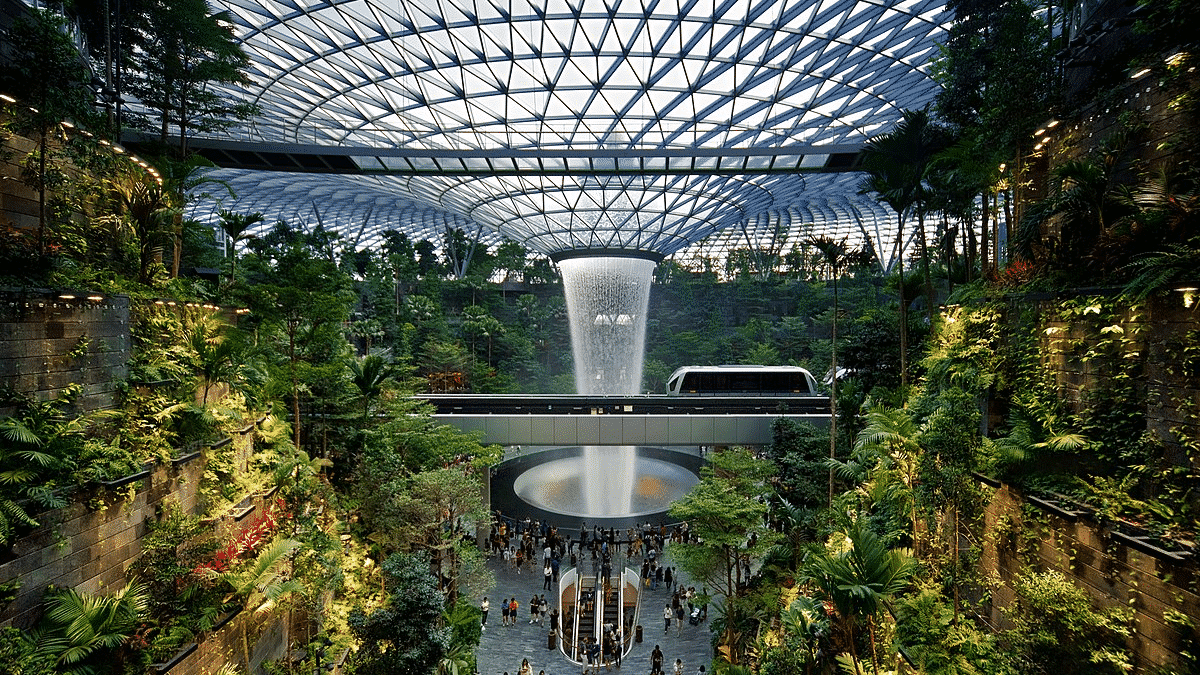You Wouldn’t Plagiarize an Airport
Maybe I would...

In what has to be one of the more bizarre plagiarism stories in recent memory, Qatar Airways accused Singapore’s Changi Airport Group of plagiarizing not a paper, an idea or a proposal, but an airport.
The accusation was made by Akbar Al Baker, who is the CEO of both Qatar Airways and Hamad International Airport. In a recent press conference, he claimed that Singapore’s Changi Airport was a plagiarism of a planned expansion of Hamad International Aiport in Doha, Qatar.
“When I show you the images later [of the planned expansion], you will realize that somebody copied our design, which was already on the table nearly six years ago … We had individuals from that country, I will not name it, that took our design and did it.”
Though Al Baker did not name the country by name, most sources indicate that he was referring to Changi Airport in Singapore.
To that end, the resemblance between the two is striking. Both airports feature large glass ceilings with triangular frames, mammoth indoor waterfalls and lush green spaces for travelers to roam.
However, the Changi Airport Group has responded to the allegations saying that they began the competitive process for the redesign and awarded it in May 2013. According to them, the company that won has never done any business in Qatar and its CEO has never traveled to Qatar.
Though Al Baker has not responded to the rebuttal, it appears that actual plagiarism is at best highly unlikely if not completely impossible. Basically, two airports had similar designs and that led to some allegations of plagiarism. But what does the law say about this and could it ever happen?
Not only could it happen, it very likely has.
A Weak Allegation (At Best)

To be clear, Al Baker and Hamad International never had a very strong case. They were accusing a Singapore airport that opened in April of this year of being a plagiarism of a project that they haven’t even broken ground on.
Given how much time, energy and resources go into designing and renovating an airport, the dates were never going to line up. When your airport isn’t going to be completed until 2022, it’s tough to claim that an already-open airport plagiarized it.
But this isn’t the first allegation of airport plagiarism. In 2018, architect Duangrit Bunnag was accused of plagiarizing their design for an airport terminal in Bangkok, Thailand. Bunrag won a contest for the job after the original winner was disqualified for failing to file the needed paperwork.
In this case, Bunrag was accused of plagiarizing not another airport but another architect, Kengo Kuma. Bunrag flatly denied the allegations saying that his design was inspired by the Thai forest and others noted that the elements that were alleged to be copied predated Kuma and were parts of traditional building techniques in the region.
Also, in a moment of irony, Hamad International Airport itself was accused of looking similar to Ben Guiron Airport in Israel back in 2014. However, no serious allegations of plagiarism arose from that case.
While it’s clear that this isn’t the first case of an airport being accused of plagiarism, it is certainly an interesting one and it is indicative of what is likely to be a growing trend.
What Does the Law Say
Though the United States isn’t relevant to these cases, it is the easiest for us to examine. Here, the law here is pretty clear. Architectural works are protected under copyright and have been since December 1, 1990. Likewise, three-dimensional artwork such as sculptures can be protected as well as other artistic elements that are not simply useful articles.
This means that building a substantially similar building without a license could be a copyright infringement. Even if the plans themselves were not copied, even an attempt to mimic another architectural work could be an infringement.
But while it’s certainly possible that a claim of copyright infringement could come from this kind of plagiarism, Al Baker would likely have an uphill battle proving it.
First, he would have to show that the architects of Changi Airport had access to his plans. If infringement is not physically possible, then no infringement took place, it’s that simple. That’s a huge hurdle in this case with the timing of everything. Proving that an already-completed airport infringed on one that hasn’t broken ground is going to be, at best, difficult.
But, even if that hurdle can be crossed, it’s still an uphill battle. Not all inspiration is infringement. Al Baker would still have to prove that the elements that were copied can be protected by copyright and are unique to his work. Elements such as indoor waterfalls and glass ceilings are hardly unique to any one architectural work.
If the case went to a court in the United States, Al Baker would likely struggle to get it off the ground. That said, the laws in Singapore and Qatar may be different enough to make such a case easier.
Still, that seems like a moot point. There’s no indication that Al Baker has any intention of filing a lawsuit or taking any further action beyond his press conference. The case, it seems, is closed for now.
Bottom Line
The story is an interesting one but, ultimately, is something of a novelty. It’s more interesting due to its rareness than its implications for others.
Still, it’s fascinating to think about the boundaries between inspiration and infringement when dealing with works of architecture. In the United States, this is a relatively new area of copyright (less than 30 years old) and there’s a lot less information on it available than with other areas.
Though this story appears to be a false alarm, it’s only a matter of time before someone does plagiarize an airport and it does make it to court as a copyright infringement.
It may wind up being a hot topic of conversation not just for the legal world, but the academic one as well.
Header Image Attribution: Matteo Morando [CC BY-SA 4.0] [Source Link]
Want to Reuse or Republish this Content?
If you want to feature this article in your site, classroom or elsewhere, just let us know! We usually grant permission within 24 hours.
